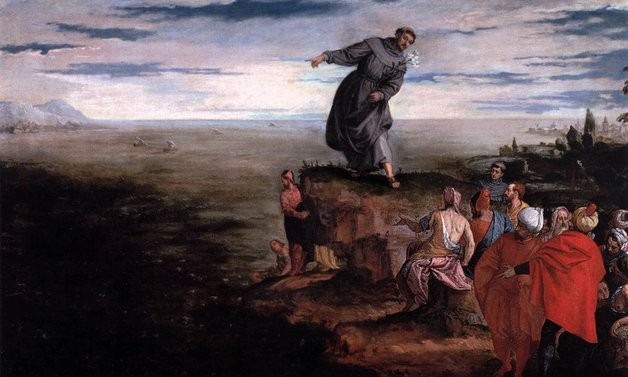St. Anthony of Padua, affectionately known as the “Hammer of the Heretics,” had a similar background and character to that of his contemporary, St. Dominic. Both friars came from a noble family, had an early desire to live religious life, and each forswore his wealth and status to follow Jesus more fully. Both Dominic and Anthony spent much of their time preaching to the Cathar heretics. Men recognized for their brilliance, they desired to preach for the salvation of souls. Although quite learned, the humility of both men often shone more brightly than their learning. So desirous to enter into a life of penance and prayer was St. Anthony that it seems his brethren assumed him to be of simple mind and only able to pray the breviary and Missal, despite his noble blood and powerful skill in learning and memory.
One account of the saint’s life relates a tale of an ordination of some Franciscan and Dominican friars both, and at the gathering of the brethren the superiors desired that someone be designated to preach. Although the superiors had approached the Dominicans first, all of them declined claiming not to have anything prepared. They then appointed St. Anthony to preach. Much to the surprise of all, since he had never before displayed his brilliance, he delivered a most astounding homily full of erudition and sublime doctrine. It was upon this occasion that his public career began.
St. Anthony’s iconography often depicts him carrying the Christ child. Though this is a popular legend with no certified documentation, we can draw several spiritual points in meditating on this figure. One powerful point is the love and tenderness with which St. Anthony gazes upon the little Jesus, holding Him close to his person. Like Mary who “kept all these things, reflecting on them in her heart” (Lk 2:19), St. Anthony treasured the Word of God made flesh and carried Him with him no matter where he went. And as Paul says in today’s reading from the second letter to the Corinthians, St. Anthony gazed “with unveiled face on the glory of the Lord” and was “transformed into the same image [of Christ Jesus] from glory to glory, as from the Lord who is the Spirit.” Our witness of this is the example of St. Anthony’s life. His sanctity was evident to all and his teachings important for the doctrine of the Church, hence his being named a Doctor of the Church.
Finally, St. Anthony kept Jesus’ Eucharistic body close to his heart. Strengthened and encouraged by his love for the Eucharist, evident in that frequently depicted vision of the loving look between the Saint and the child Jesus, St. Anthony strove to be a “slave for the sake of Jesus.” He sought to proclaim the power and mystery of the Eucharist and serve God among the heretics as one who was “sent,” an apostle. In both frequency and intensity St. Anthony loved, received, and proclaimed the Eucharist.
We may wonder at the zeal that consumed St. Anthony to proclaim the truth of Christ Jesus among the dangerous heretics, but it is no wonder that his zeal and authentic love for and service to Jesus have remained as a legacy behind him, earning him the title of thaumaturge, wonder-worker. St. Anthony, holy friar, Hammer of the Heretics, pray for us.
✠
Image: Paolo Veronese, St. Anthony Preaching to the Fish







